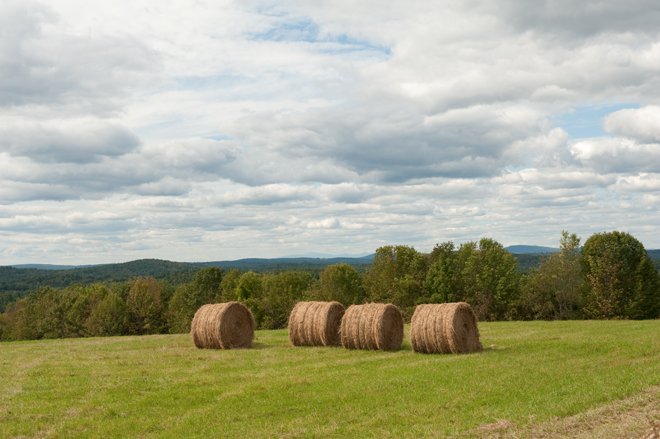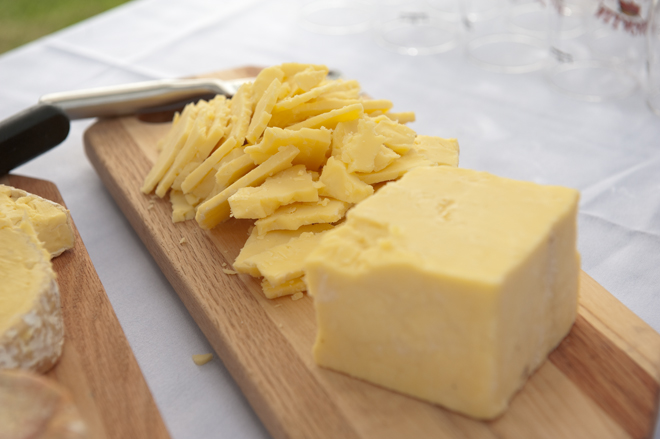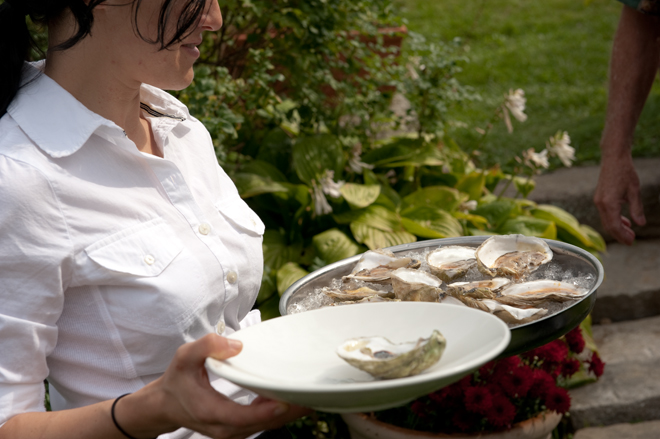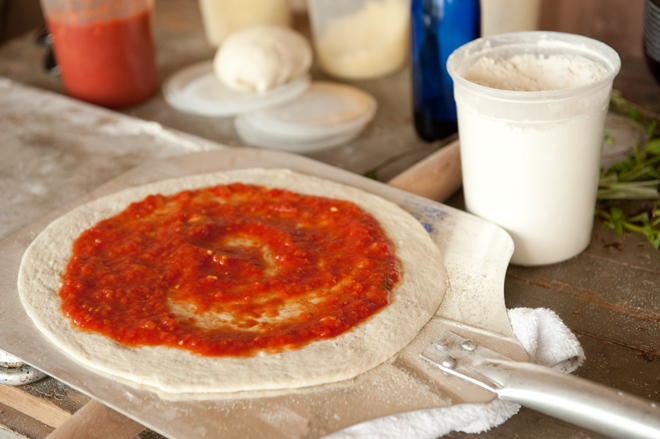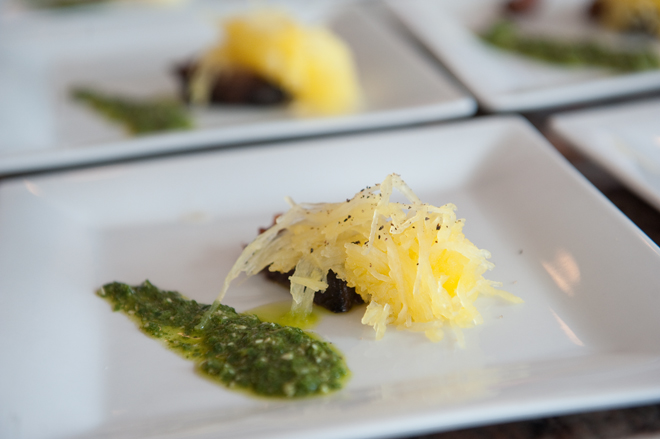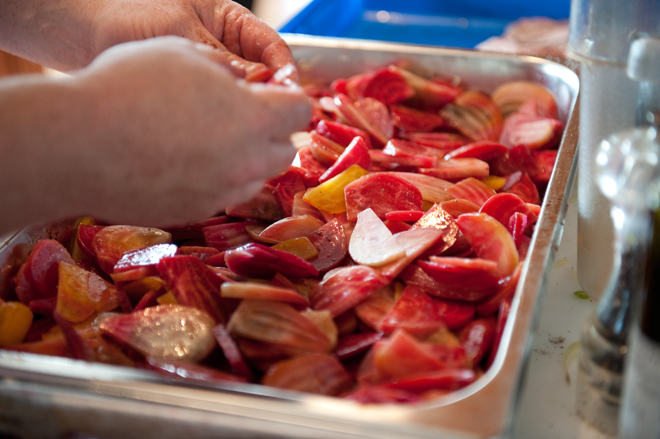Harvest Dinner at Grand View Farm
EAT FEATURE-January/February 2012
By Joe Ricchio
Photographs by Ted Axelrod
Farm-to-table dining is alive and well at Grand View Farms annual Harvest Dinner, which puts a spotlight on the best of the season. There is also plenty of wine…
I don’t think anyone would argue with me when I say that the best way to enjoy a “farm-to-table” dining experience is to do so on an actual farm. If there is any potential confusion about a particular ingredient’s place of origin, it can be cleared up by pointing to its source a few dozen yards away.
Lee Skawinski, co-owner and executive chef of the restaurants Cinque Terre and Vignola in Portland, started preparing annual harvest dinners at Grand View Farm in Greene about seven years ago. The farm is owned by Skawinski’s business partners, Dan Kary and Michelle Mazur-Kary, who felt it would be a perfect venue to showcase the local ingredients often found on Skawinski’s menus. What started as an intimate dinner for eight of Cinque Terre’s regular customers has grown in size and scope each subsequent year, reaching a guest list of 81 for the most recent event.
Although the dinners are an annual event, Grand View Farm is in production year-round. Skawinski explains that the farm is largely maintained by staff from both restaurants who make up to 20 trips each growing season to work in the fields, about 15 of which are visits reserved for tedious activities such as weeding.
“Each year we see what works, and we continue to add new crops based on our results,” Skawinski says. “The more work we put in, the better the end result. As of late, we have been specializing in Italian vegetable varieties, as they are the focus for the cuisine served at the restaurants. And the more familiar I become with growing, the more I can plan my menus around the crops.”
Naturally, I’m excited to attend this year’s festivities, which fall on a crisp, autumn Sunday. However, the “festivities” that occurred on the preceding Friday and Saturday nights left me a bit worse for wear as I make my way toward the chartered bus that will transport everyone to Greene, about 45 minutes away. While fending off waves of nausea in my seat at the very back of the bus, I promptly make friends with four self-proclaimed “troublemakers” who, unbeknownst to all involved, would be dining at my table later that afternoon.
Because I was once an employee of Cinque Terre years ago, this is not my first trip to Grand View Farm. At the 2003 summer staff party, I displayed interest in one of Kary’s tractors, and he responded by asking if I’d like to “take it for a spin.” Of course, he had no idea how much wine I had already consumed. As he began to explain the controls to me, I thrust my drink into his hand, ordered him to “hold this,” and assured him that “I know what I’m doing.” As the tractor began to lurch down the small dirt road, I became painfully aware that the shifter and brake were not in the usual locations, which prompted a more mechanically inclined employee to chase after the tractor, hop on, and rescue me from imminent disaster. On my unceremonious return, Kary asked me why I didn’t turn the tractor around as I had been instructed, to which I replied, “I didn’t want to go off the road.” He reminded me that “it’s a tractor,” implying that the machine is specifically designed to go off road, before sending me back to the barbecue to eat more pulled pork.
When we arrive, I can see many changes since 2003, most notably the addition of a new greenhouse. After debussing, I’m greeted by the familiar face of Eli Cayer, owner of the Urban Farm Fermentory in Portland. He is taking the opportunity to promote both his hard ciders and his recently launched line of kombucha beverages. This, of course, is a combination of beverages that could not be more welcome in my current condition. After tossing back a few glasses of each and sampling a few of the local cheeses laid out on the table, such as Hahn’s End Olde Shiretowne, I’m feeling much more even-keeled and ready to navigate social situations.
Making my way to greet Skawinski and his crew, hard at work in the kitchen, I notice several crates of lettuce being brought in from the fields. Skawinski, whom I’ve known for more than a decade, informs me that I will be dining at the “kitchen table” to ensure that I don’t miss any of the action.
Other diners roam about the yard sampling drinks from local breweries such as Allagash, while a band plays quietly and unobtrusively in the background. I notice an amazing wood oven next to the pool, where a raw veal roast, all laced up like Betty Page and slathered in rosemary, is about to become a whole hell of a lot more delicious.
Five separate rooms in the house have been transformed into dining spaces in addition to the kitchen itself. Servers roam about passing out appetizers, such as Winter Point oysters with tomato horseradish mignonette, yellow- and cherry-tomato arancini with lemon-basil aioli, and Stoneheart Farms lamb sausage with peach mostarda, housemade mortadella, and pickled blue hubbard squash.
As dinnertime draws near, I meet Chris Campbell of C&P Wines, who represents the Spanish producers whose wares we will be enjoying this afternoon. Luckily, he is also seated at the kitchen table with us, guaranteeing that at no point henceforth will my glass be empty. As diners begin to settle in, we are presented with baskets of bread that were baked in the wood oven adjacent to the kitchen.
The first wine poured is Poderi Capecci San Savino’s Pecorino Offida Ciprea, a bracing and fruity Italian white made from the rather obscure pecorino grape. It’s a harmonious pairing with the kitchen’s first plate—delicately braised Longfellow Farms pork belly with strands of spaghetti squash and an earthy sage and walnut pesto.
As with any event that utilizes a high-end home kitchen to plate up meals for more than 80 people, chefs are forced to get creative with the utilization of space. Skawinski appears to have mastered this setup, however, and everything flows effortlessly.
Heirloom beets add an unbelievably flavorful and robust element to a salad of red sails lettuce with shaved, crunchy fennel and paper-thin, melt-in-your-mouth Stoneheart Farms lamb carpaccio. Bodegas y Vinedos Ponce’s Manchuela La Casilla–Estrecha, a dark ruby-colored wine made from the bobal grape, provides many elements that make it a surprising yet harmonious accompaniment to the salad. These include notes of black raspberry, mineral, and lavender.
At this point, spirits are becoming a wee bit elevated among my fellow dining companions. As I continue to yammer away at them while snapping photos, it dawns on me that, given that it is only three in the afternoon, this may be a long evening after all.
I hardly have a moment to reflect on this realization before I am presented with light, fluffy potato gnocchi resting in a pool of heirloom-tomato sauce with flecks of basil and a dollop of fresh, creamy burrata cheese perched on top. To wash it all down, we have been provided with a glass of Vietti’s Barbera d’Asti Tre Vigne from Piedmont, which is quite soft in texture and saturated with cherry, vanilla, and oak favors. The wine just barely stands up to the acid in the tomato sauce but pairs extraordinarily nicely with the cheese.
Finally, I see Betty Page, hot and sweating from the wood oven, making her way to the carving station. The veal roast is barely being held together by the butcher’s twine—it’s always a good sign when the meat peels away at the touch of the knife. We are each given a healthy slab, with a smear of creamy and tangy tonno sauce alongside. Turnip gratin, sautéed greens, and fried capers make this course a meal unto itself. As Campbell reckoned, the Bodegas Rejadorada Temple wine from Toro, a much more aggressive red, works brilliantly here. Composed of 100 percent tempranillo, it is silky and spicy, with long, drawn out expressions of plum and wild blackberry.
As we witness each of the honey-almond tarts with farm-peach preserve being carefully garnished with a magnificent crown of spun sugar, many of my fellow diners, now growing a bit intoxicated, begin to stand up and meander around. I become aware of this only because most of those who remain seated at our table end up with multiple desserts. Nobody seems to mind, since the delicious confections have been paired with a glass of Querciavalle Vin Santo, a sweet yet tangy Italian dessert wine made from malvasia and trebbiano.
After dinner, I refill my glass with the La Casilla Estrecha from course two and begin wandering around the farm, enjoying the sunset and admiring the tractors that I will never again be given permission to ride. In recent years, farm-to-table has become something of a buzzword that’s thrown around recklessly and applied loosely. It’s comforting to see that Skawinski and company still embody the origins and culinary authenticity that gave rise to the farm-to-table movement. Hopefully, these diners will continue to attend this event for many years to come. In the meantime, one can enjoy much of this great produce at both Cinque Terre and Vignola, without the 45-minute bus ride into the country.
Cinque Terre | 38 Wharf St. | Portland | 207.347.6154 | cinqueterremaine.com
Vignola | 10 Dana St. | Portland | 207.772.1330 | vignolamaine.com






